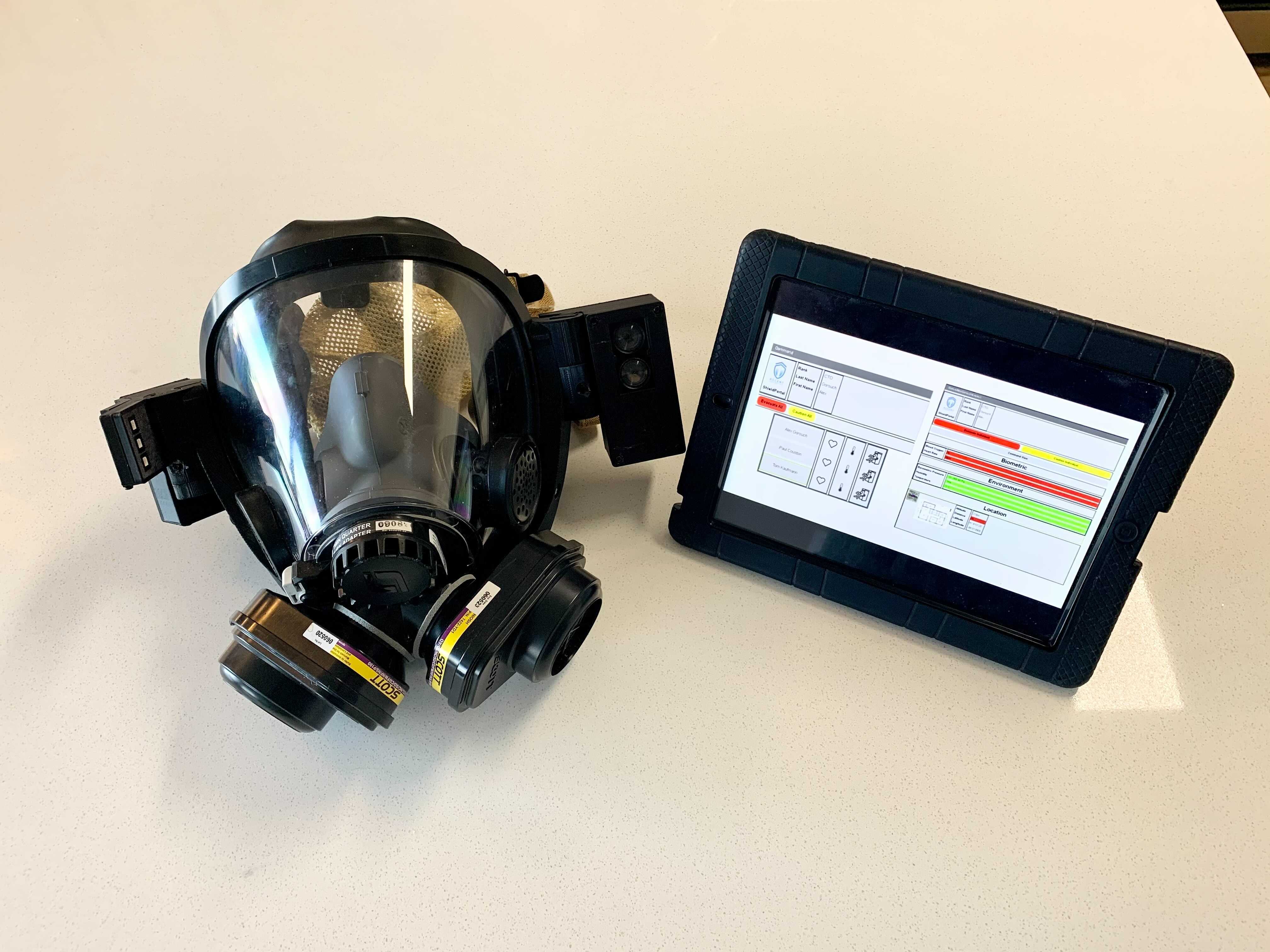By FRED KRONER
Coming up with innovative ideas is not the issue for Mahomet’s Alex Gorsuch.
The challenge is creating interest in the novel concepts.
“It’s easy to build hardware,” Gorsuch said. “It’s much harder to build hardware that a real customer with real money and a real problem will be motivated by.
“Inertia is the single greatest competitor of any tech business. Customer understanding through discovery is the secret.”
Gorsuch and his collaborator, Naperville’s Paul Couston, hit upon a venture which could make a name nationally for the startup company they co-founded, Ascent Integrated Tech.
They are developing a product that, Gorsuch said will, “make the world a safe place for firefighters.”
He added: “Hazardous respirators are worn by firefighters, industrial operators, and avionic mechanics. These respirators can cost up to $10,000 per unit but currently have less sensor technology than a $100 smartwatch.”
The team was originally spurred by an opportunity with special operations command to make tactical respirators for special operators easier to use and to reduce burden.
“While iterating and discovering this problem, we discovered that there are huge needs in the fire industry to revolutionize how those who put their lives on the line communicate and navigate in austere environments,” Gorsuch said.
That knowledge put the wheels in motion and they entered into the research phase.
“We talked to over 100 fire chiefs across the U.S.,” Couston said. “We have learned there’s a huge need for improved communication and actionable insights for firefighters and the incident commander (fire captain).
“We also learned it’s important to integrate into existing equipment as this eases the technology’s adoption. The incident commander lacks insight into the squad’s biometric, environmental, and locational data in the building.”
Ascent is building human performance technology to augment operators in hazardous environments with actionable insights that improve safety and productivity.
Their creation will be test-marketed this summer with over 20 departments in 17 states (and Washington, D.C.).
“All this sensor data streams to a web application which can be viewed live-time by the incident commander via a laptop or tablet,” Couston said. “This information can also be viewed and replayed after the incident for training purposes, investigation, or review via clinicians.”
One key, Gorsuch said, is to maintain equipment with which firefighters are already familiar.
“Our approach is agnostic to the respirator, industry, and OEM, and we integrate into existing solutions and brands that these operators know and trust,” Gorsuch said. “Our technology enables reliable communication, interchangeable and wireless components, optical, environmental, and biometric sensors, and can monitor the locations and movements of the operators.
“All this is done without changing the fundamental functionality, gasket, or respiration function of the equipment.”
Citing statistics from a 2020 study by the National Fire Protection Association that show nearly two-thirds (64 percent) of injuries to firefighters are caused by preventable measures that can be tackled using proper monitoring GFS tracking and communications, Gorsuch and Couston’s goal is to improve safety and production.
“For example, one of the largest causes of death in the fire service is heart attacks within 24 hours after the fire,” Gorsuch said. “We believe our biometric sensors integrated into firehoods can make a meaningful difference.”
The entrepreneurs said the biggest thing involved in getting their concept from the planning stage to a product for the marketplace was not the direct build.
“Paul and I have both spent our careers building hardware,” Gorsuch said. “It’s crucial to consistently use the principles of lean launch and customer discovery to make sure that actual customers are involved at every step of the process.
“Specifically, we started with an airsoft mask with sensors hot glued on the inside. Next, we integrated said sensors and 3D printed enclosures into a commercial 3M respirator mask. Next, we integrated into a fire service mask and developed a patent-pending connection system which transfers both data and power.”
As they consulted representatives of the National Fire Protection Association, the men recognized that some production changes would be needed.
“We originally had a heads-up display inside the mask at this stage, much like you’d see in an Iron Man movie,” Gorsuch said. “From talking to the NFPA, we learned it’s also crucial to not have any electronics inside the mask, so we pivoted to an LED base alert system in the peripheral vision.
“Concurrent to this, we’ve also been developing an app for the fire captain to observe the biometric, environment, location of the squad in the building.”
They expect to have a voice in future changes.

“We have been invited to join some technical committees specifically on writing regulations for SCBA for the fire service,” Gorsuch said.
The production workload will be more than they can handle themselves.
“To meet the demand for these upcoming pilots, we are growing our team,” Couston said. “We recently closed a $400,000 round joined by strategic partners like MHUB, Dipalo Ventures, Fox Ventures, Illinois Ventures, and the Darley Company, one of the largest global fire equipment distributors.”
As part of their expansion, Gorsuch said, “we recently added an engineering hire, a sales hire, along with a cohort of students.”
***
The venture by Gorsuch and Couston started remotely.
“My co-founder and I met while mentoring hardware teams through UIUC’s iVenture program, which fosters innovation and entrepreneurship,” Gorsuth said. “We’ve both formed tech companies before, in particular in the defense space, and we each kept telling teams similar advice on being lean, customer-focused, and utilizing the Department of Defense funding mechanisms like the SBIR program.
“Eventually we met, and after a few bottles of mead, we decided to start Ascent Integrated Tech.”
They recently leased a workspace in Champaign at EnterpriseWorks at the University of Illinois Research Park.
“This helps us get closer to the Illinois Fire Service Institute to get immediate feedback and run live-burn testing,” Couston said.
“In addition to the new space at Research Park, we are also starting an accelerator program with MHUB Chicago, a hardtech maker space for new start-ups. They have over $6 million worth of prototyping equipment, and we plan to leverage this from our upcoming summer pilots.
“We are also exploring opportunities with the Department of Defense, especially with avionic and marine mechanics as well as special forces operators.”
Both men have a strong background in tech and development.
Couston even put his education at the University of Illinois on pause to get some practical experience.
“I started my first venture, Optivolt Labs, when I was a sophomore studying industrial engineering at UIUC,” Couston said. “I took some time off my undergrad to join Techstars Chicago with my co-founders, who I had met during the iVenture Accelerator program on campus.
“Optivolt integrates battery-powered machines with self-charging solar capabilities. We integrated solar into laptops, phones, scooters, and drones; and eventually moved out to the Bay Area and started building deployable solar tech for the Air Force.
“All in all, I helped Optivolt secure $3.5 million in Venture Capital and Department of Defense contracts, but I left that venture due to complications during covid.”
Couston returned to the UI campus to complete his undergrad requirements and mentor teams at the iVenture Accelerator, where he met Gorsuch virtually.
Gorsuch’s credentials are also impressive.
“I’ve built many products mostly for the national security market, some ag, some biomedical,” Gorsuch said. “First business, I built portable modular microbiology labs for the warfighter, which allowed for enhanced chemical, biological, radiologic and nuclear defense with on-site ruggedized testing.
“A lot of my career has been spent on low SWaP-C (size, weight, power, cost) rugged stuff like tactical autonomous systems, diagnostics, human performance tech, sensor tech.
“Our current prototype has withstood being run over, immersed in water, lit on fire, hit with a hammer and sledgehammer. We’ve even gone as far as testing its durability with a firearm. However, if our firefighters are being shot at, we’ve got bigger problems.
Gorsuch also taught courses at the University of Illinois (in Champaign) NSF I-Corps (customer discovery program for tech startups), and Hacking for Defense, teaching students to form businesses solving technical problems for the Department of Defense and NATO.
“The massive change in culture has been really astounding at the Department of Defense,” Gorsuch said. “They’ve realized the next near-peer adversary war won’t be won by handsome athletes, but by ugly nerds and innovative tech.
At the end of April, Gorsuch left behind his university roles to devote full attention to Ascent.
Gorsuch and Couston have secured all of their pilots through direct outreach.
“As UIUC alums, we are heavily involved in the entrepreneurial ecosystem, mentorship is incredibly important to us,” Gorsuch said. “Technology innovation is a primary economic driver, additionally it is a key component of our national security.”
With Ascent, they are on the cutting edge of advancements and innovations. For more information, visit www.ascentitech.com.



